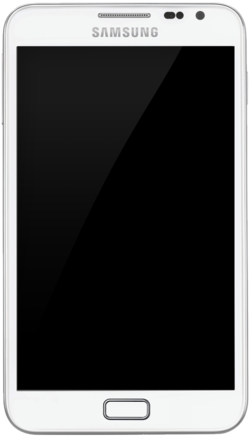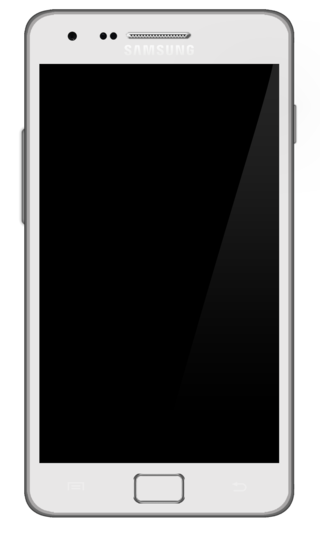
The Samsung Galaxy S II is a touchscreen-enabled, slate-format Android smartphone designed, developed, and marketed by Samsung Electronics, as the second smartphone of the Samsung Galaxy S series. It has additional software features, expanded hardware, and a redesigned physique compared to its predecessor, the Samsung Galaxy S. The S II was launched with Android 2.3.4 "Gingerbread", with updates to Android 4.1.2 "Jelly Bean".

S Pen (Korean: S펜) is a wireless digital pen stylus designed and developed by Samsung Electronics featuring Wacom's digital pen technology. It is made for use with supported Galaxy mobile devices like smartphones and tablets, as well as selected Samsung Notebook, Samsung Galaxy Book, and Chromebook notebooks. It was first released with the Samsung Galaxy Note series in 2011, becoming a core feature of the Note line of products. The S Pen supports features such as translating text by hovering the pen, and creating animated messages.
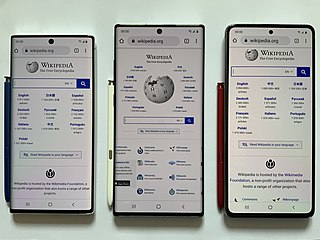
A phablet is a mobile device combining or straddling the size formats of smartphones and tablets. The word is a portmanteau of phone and tablet. The term is largely obsolete by the late 2010s, since average smartphone sizes eventually morphed into small tablet sizes, up to 6.9 inches (180 mm), with wider aspect ratios.

The Samsung Galaxy Note II is an Android phablet smartphone. Unveiled on August 29, 2012 and released in October 2012, the Galaxy Note II is a successor to the original Galaxy Note, incorporating improved stylus functionality, a larger 5.5-inch (140 mm) screen, and an updated hardware and casing design based on that of the Galaxy S III.

The Samsung Galaxy S4 is an Android smartphone produced by Samsung Electronics as the fourth smartphone of the Samsung Galaxy S series and was first shown publicly on March 14, 2013, at Samsung Mobile Unpacked in New York City. It is the successor to the Galaxy S III, which maintains a similar design, but with upgraded hardware, more sensors, and an increased focus on software features that take advantage of its hardware capabilities—such as the ability to detect when a finger is hovered over the screen, and expanded eye tracking functionality, it was released the previous year. A hardware variant of the S4 became the first smartphone to support the emerging LTE Advanced mobile network standard. The T-Mobile version of the Galaxy S4, named the model (SGH-M919), was released the same month. The phone's successor, the Samsung Galaxy S5, was released the next year.

The Samsung Galaxy Note series was a line of high-end flagship Android phablets and smartphones developed and marketed by Samsung Electronics. The line is primarily oriented towards pen computing; all Galaxy Note models shipped with a stylus pen, called the S Pen, and incorporate a pressure-sensitive Wacom digitizer. All Galaxy Note models also include software features that are oriented towards the stylus and the devices' large screens, such as note-taking, digital scrapbooking apps, tooltips, and split-screen multitasking. The line served as Samsung's flagship smartphone model, positioned above the Galaxy S series.
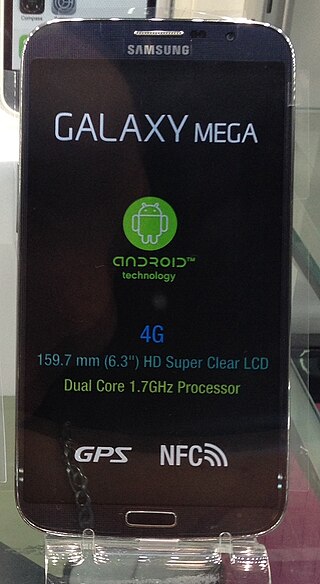
The Samsung Galaxy Mega is an Android-based phablet that was manufactured and released by Samsung. It was announced on April 11, 2013. The original model featured a 6.3 in (160 mm) screen, though a revised version was released with a 5.8 in (150 mm) screen. It has a 1,280×720 screen, a dual-core 1.7 GHz processor and an 8-megapixel camera. The phone runs Android 4.2.2 "Jelly Bean" software, and internal storage is 8 or 16 GB.
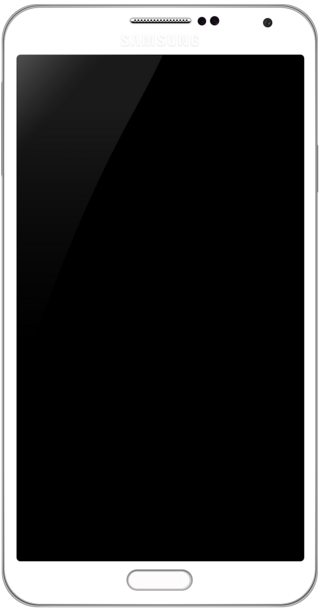
The Samsung Galaxy Note 3 is an Android phablet smartphone produced by Samsung Electronics as part of the Samsung Galaxy Note series. The Galaxy Note 3 was unveiled on September 4, 2013, with its worldwide release beginning later in the month. Serving as a successor to the Galaxy Note II, the Note 3 was designed to have a lighter, more upscale design than previous iterations of the Galaxy Note series, and to expand upon the stylus and multitasking-oriented functionality in its software—which includes a new pie menu opened through the button on the stylus for quick access to pen-enabled apps, along with pop-up apps and expanded multi-window functionality. It additionally features new sensors, a USB 3.0 port, 3 GB of RAM, and its video camera has been upgraded to 2160p (4K) resolution and doubled framerate of 60 at 1080p, placing it among the earliest smartphones to be equipped with any of these.

The Samsung Galaxy Note 4 is an Android smartphone developed and produced by Samsung Electronics. It was unveiled during a Samsung press conference at IFA Berlin on 3 September 2014 and was released globally in October 2014 as successor to the Samsung Galaxy Note 3. Improvements include expanded stylus-related functionality, an optically stabilized rear camera, 1440p quad-HD filming on the front camera, significantly increased charging rate, revised multi-windowing, and fingerprint unlocking. It is the last in the Samsung Galaxy Note series with interchangeable battery. Its subsequent model, the Samsung Galaxy Note 5, was unveiled on 13 August 2015.

The Samsung Galaxy S5 is an Android-based smartphone unveiled, produced, released and marketed by Samsung Electronics as part of the Samsung Galaxy S series. Unveiled on 24 February 2014 at Mobile World Congress in Barcelona, Spain, it was released on 11 April 2014 in 150 countries as the immediate successor to the Galaxy S4. As with the S4, the S5 is an evolution of the prior year's model, placing a particular emphasis on an improved build with a textured rear cover, IP67 certification for dust and water resistance, a more refined user experience, new security features such as a fingerprint reader and private mode, expanded health-related features including a built-in heart rate monitor, a USB 3.0 port, and an updated camera featuring speedy auto-focus through phase-detection. The video resolution has been upgraded to 2160p (4K) and the frame rate at 1080p has been doubled to 60 for a smooth appearance.

The Samsung Galaxy Note 3 Neo is an Android phablet smartphone produced by Samsung Electronics. The Galaxy Note 3 Neo was unveiled by Samsung Poland on February 1, 2014, with its worldwide release later in that month. Serving as a lower priced version of the Samsung Galaxy Note 3, the Note 3 Neo was designed to have the same lighter, more upscale design than previous iterations of the Galaxy series first supported by its bigger sibling, and to expand upon the stylus and multi-tasking oriented functionality in its software, which includes the new navigation wheel for pen-enabled apps, along with pop-up apps and expanded multi-window functionality, while lacking more sophisticated functionality such as 1080p video recording and USB 2.0 port.

The Samsung Galaxy Note Edge is an Android phablet produced by Samsung Electronics. Unveiled during a Samsung press conference at IFA Berlin on September 3, 2014, alongside its sister, the Galaxy Note 4, it is distinguished by a display that curves across the right side of the device, which can be used as a sidebar to display application shortcuts, a virtual camera shutter button, notifications, and other information.

The Samsung Galaxy Note 5 is an Android-based smartphone designed, developed, produced and marketed by Samsung Electronics. Unveiled on 13 August 2015, it is the successor to the Galaxy Note 4 and part of the Samsung Galaxy Note series.

The Samsung Galaxy S7, Samsung Galaxy S7 Edge and Samsung Galaxy S7 Active are Android-based smartphones manufactured, released and marketed by Samsung Electronics. The S7 series serves as the successor to the Galaxy S6, S6 Edge, S6 Edge+ and S6 Active released in 2015. The S7 and S7 Edge were officially unveiled on 21 February 2016 during a Samsung press conference at Mobile World Congress, with a European and North American release on 11 March 2016. The S7 Active was unveiled on 4 June 2016, and released on AT&T in the United States on 10 June 2016.

The Samsung Galaxy A series is a line of mid-range smartphones and tablets manufactured by Samsung Electronics as part of their Galaxy line. The first model in the series was the first-generation Galaxy Alpha, released on 31 October 2014.
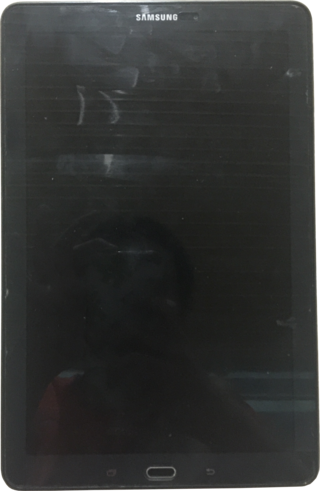
The Samsung Galaxy Tab A 10.1 is a 10.1-inch Android-based tablet computer produced and marketed by Samsung Electronics. It belongs to the mid-range "A" series, which also includes 7, and in the past, 8 and 9.7-inch models. It was released in May 2016; the S-Pen (stylus) version was released in September 2016.A refreshed version of the tablet would later be released in 2019, with some aspects, such as the battery, being reduced, while other components were upgraded.

The Samsung Galaxy Note 8 is an Android-based smartphone phablet designed, developed, produced and marketed by Samsung Electronics. The successor to the discontinued Samsung Galaxy Note 7, Samsung Galaxy Note Fan Edition and Samsung Galaxy Note 5, it was unveiled on 23 August 2017 and became available on 15 September 2017.

The Samsung Galaxy S9 and S9+ are Android-based smartphones unveiled, manufactured, released and marketed by Samsung Electronics as part of the Samsung Galaxy S series. The devices were revealed at the Mobile World Congress in Barcelona on 25 February 2018, as the successors to the Samsung Galaxy S8 and S8+.
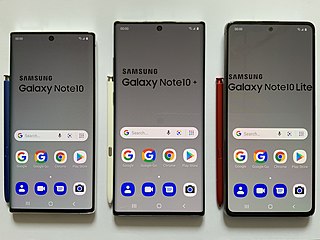
The Samsung Galaxy Note 10 is a line of Android-based phablets designed, developed, produced, and marketed by Samsung Electronics as part of the Samsung Galaxy Note series. They were unveiled on 7 August 2019, as the successors to the Samsung Galaxy Note 9. Details about the phablets were widely leaked in the months leading up to the phablets' announcement.

The Samsung Galaxy Note 20 and Galaxy Note 20 Ultra are a series of high-end Android-based phablets designed, developed, produced, and marketed by Samsung Electronics as part of their Samsung Galaxy Note series, succeeding the Samsung Galaxy Note 10 series. The phablets were announced on 5 August 2020 alongside the Samsung Galaxy Z Fold 2, Galaxy Watch 3, Galaxy Buds Live and Samsung Galaxy Tab S7 during Samsung's Unpacked Event. It was the final model in the Galaxy Note series, with Samsung beginning to integrate the functionality from the Note series into its S series "Ultra" models, starting with the Galaxy S20 Ultra.

